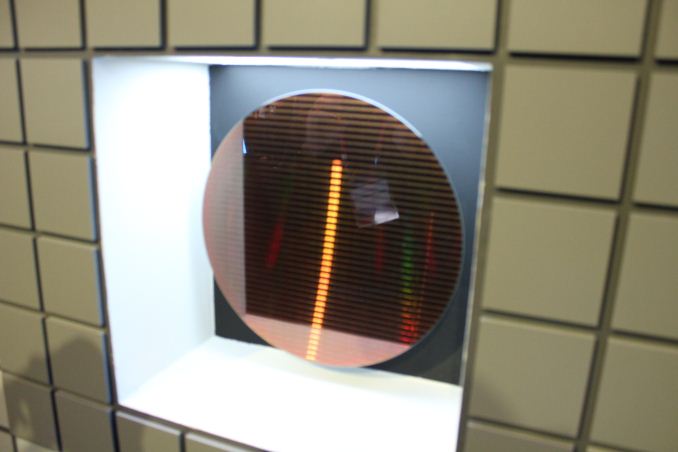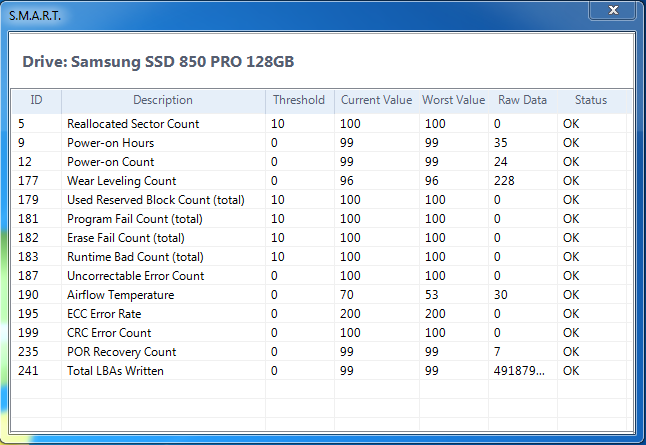Testing Samsung 850 Pro Endurance & Measuring V-NAND Die Size
by Kristian Vättö on July 7, 2014 1:20 PM EST
Last week Samsung announced the 850 Pro, which is the first mainstream SSD to utilize 3D V-NAND. We already reviewed the drive and covered the fundamentals of V-NAND in detail but there is one thing I did not have the time to test: endurance. The most promising aspect of V-NAND is its increased endurance and Samsung has claimed endurance of up to ten times of 2D NAND. However, the 850 Pro is only rated at 150TB, which is twice the rating of 840 Pro, so I wanted to dig deeper and determine the endurance rating in terms of program/erase cycles.
To calculate the P/E cycles, I used a method similar to what we used with the SSD 840 two years ago. Basically, I wrote 128KB sequential data (QD1) to the drive and wrote down the necessary SMART values as well as the average throughput after every test. After repeating the test over a dozen times, I had enough data to figure out the P/E cycle count.
The Wear Leveling Count (WLC) SMART value gives us all the data we need. The current value stands for the remaining endurance of the drive in percentage, meaning that it starts from 100 and decreases linearly as the drive is written to. The raw WLC value counts the consumed P/E cycles, so if these two values are monitored while writing to the drive, sooner than later we will find the spot where the normalized value drops by one.
I found that the current WLC value drops by one after 60 P/E cycles (I ran the test over multiple WLC drops), which suggests that the WLC will drop to zero after 6,000 P/E cycles. In other words, the V-NAND in 850 Pro is good for 6,000 P/E cycles, which is twice the cycle count of modern 2D MLC NAND but quite far away from Samsung's "ten times the endurance" claims. Either Samsung is using lower binned parts in the 850 Pro (i.e. saving the 30,000 P/E cycle parts for enterprise drives) or the WLC value has artificially been limited to ensure that enterprises do not use the 850 Pro and pay the premium for the 845DC EVO/Pro instead. I am thinking it is more of the latter because the enterprise drives bring home much higher profits and of course Samsung wants to make sure that the 850 Pro is not used outside the client environment.
Once WLC reaches zero or one, it is generally a good idea to replace the drive as it may no longer be reliable. However, that does not mean that the drive will immediately fail -- according to JEDEC spec the P/E cycle rating is with one-year data retention, meaning that there can still be plenty of life left. The Tech Report's endurance testing gives a good picture of how much you can write after the WLC drops to zero, although personally I would still replace the drive ASAP because there is no guarantee that each drive performs similarly (remember, NAND is binned for endurance so there can be differences).
| SSD Lifetime Estimation | ||||
| 128GB | 256GB | 512GB | 1TB | |
| Raw NAND Capacity | 129GiB | 258GiB | 516GiB | 1032GiB |
| NAND P/E Cycles | 6,000 | |||
| Raw NAND Endurance | 755.9TiB | 1,511.7TiB | 3,023.4TiB | 6,046.9TiB |
| Lifespan with 20GiB of Host Writes per Day with 1.5x Write Amplification | 35.34 years | 70.68 years | 141.37 years | 282.74 years |
| Lifespan with 100GiB of Host Writes per Day with 3x Write Amplification | 7.07 years | 14.14 years | 28.27 years | 56.55 years |
| Drive Writes per Day with 5x Write Amplification | 1.10 | 1.10 | 1.10 | 1.10 |
The above table gives a good summary of how durable the 850 Pro really is. Even if you write 100GiB (GB in Windows is really GiB, i.e. 1024^3 bytes) per day with a write amplification of three, the smallest 128GB model will last for over seven years. 100GiB per day is very rare in a client environment and to be honest I can only see this applying to some high-end media professionals that use the drive for production purposes. On the other hand, media professionals will likely spring for a larger capacity anyway as 128GB might not even be capable of holding the data of one project. For a more typical user there is absolutely nothing to worry about as the 850 Pro will likely outlive the rest of the components.
Of course, there is still the 150TB write limitation on the warranty. That figure is based on host writes, so it applies even if you are only writing sequential data with low write amplification. Samsung did, however, tell me that they can make exceptions as long as the drive is used in client environment, meaning that the purpose of the endurance rating is mostly to make sure that the 850 Pro is not used in write intensive enterprise applications.
Testing Write Amplification
In addition to testing the endurance, I decided to see what the worst-case write amplification looks like. The test regime is similar to the endurance testing but the writes are 4KB random (QD32) to illustrate the worst possible scenario for the drive. Unfortunately, Samsung's SMART values do not report total NAND writes like Intel does, but the raw Wear Leveling Count basically gives us NAND writes in increments of the capacity of the drive (one P/E cycle = 129GiB of NAND writes for the 128GB drive). I recorded the Wear Leveling Count as well as the Total LBAs Written (i.e. host writes) value while writing 4KB random data to the drive.
| Worst-Case Write Amplification | |
| Host Writes | 493.9GiB |
| P/E Cycles Consumed | 42 |
| Approximate NAND Writes | 5,418GiB |
| Observed Write Amplification | 10.97x |
About 10x worst-case write amplification is fairly typical for a moden client SSD. Fortunately the days of +100x write amplification are over and under common client workloads the write amplification will usually stay below 2x.
| Worst-Case Endurance | ||||
| 128GB | 256GB | 512GB | 1TB | |
| Write Amplification | 11x | |||
| Total Bytes Written (TBW) | 68.7TiB | 137.4TiB | 274.9TiB | 549.7TiB |
| Drive Writes per Day for 5 Years | 0.43 | 0.43 | 0.43 | 0.43 |
The table above is just to show how the 850 Pro would bear in worst-case scenario that may be relevant to some enterprise users. I will be putting the 850 Pro through our enterprise test suite to see how it stacks up in terms of performance but especially with added over-provisioning, I can see the 850 Pro being viable for some read intensive enterprise workloads.











39 Comments
View All Comments
sonicmerlin - Friday, July 11, 2014 - link
But the cost per bit would be 16x less for Samsung as well, and they could sell at the same prices as they are now while raking in preposterous margins. There must be another reason they're not printing at at least the 2X node.pukemon1976 - Tuesday, July 15, 2014 - link
Thus the stagnation in innovation in a lot of industries. Smart phones are a great example of this. Look no further than Samsung and apple. Heck, Intel should throw AMD a bone or two so there isore competition in the x86 space.MrSpadge - Saturday, July 26, 2014 - link
The 40 nm process is very mature, but can't be used for anything power or performance critical anymore. Using these fabs for 3D NAND is making good use of them. I suppose they'll transition 3D NAND to smaller geometries once competitive pressure arises or once their 32 / 28 nm fabs are not completely utilized by other chips any more.jordanl17 - Thursday, August 28, 2014 - link
I just put 16x of the 512gb Samsung EVO 850's in an Equallogic PS6000 SAN. Raid 6 w/ hot spare. pretty sick. I'm going to get some cold spares for when these babies start to fail. but I'm hoping they last a long time!mdw9604 - Saturday, October 17, 2015 - link
How did that turn out?mrigi - Friday, September 19, 2014 - link
The worst scenario is not random write across the drive and not 100GiB per day but writing zillion times a day to a single sector like Chrome browser does with it's cache/history/bookmarks. That's the real world scenario. That is what kills drives regardless their firmwares that are cool on a paper only.Have you tested that? Is this what "write amplification" test does?
frostdude2025 - Sunday, November 9, 2014 - link
what do the two situations of writing 20 gb or 100 gb at 1.5 or 3.0 write amp even look like, always wondered thisIAEInferno - Sunday, September 18, 2016 - link
Hi I'm confused, it says that the limit is 150TB write limitation or 10 years warranty for the Samsung 850 Pro, how many years exactly does the 850 pro SSD at 512gb would last me if I'm just gaming while I store my movies, music, pictures, multiplayer games and etc. on a separate HDD while I just put my OS, some games and programs in the SSD?chrcoluk - Saturday, August 14, 2021 - link
Bait and switch again?Reviewer sample 1% for every 60 cycles.
My 850 pro 63 cycles and 98%. Which seems to be 30 cycles per 1% same as their MLC 2D drives lol.
With that said the drive is a few years old now, has been used in a ps4 pro which constantly records footage, and 2-3 years in my main PC. So to be at 98% of rated cycles is very nice for that length of time. Although its about 80% of the way to rated TB of warranty which was set very low by samsung.